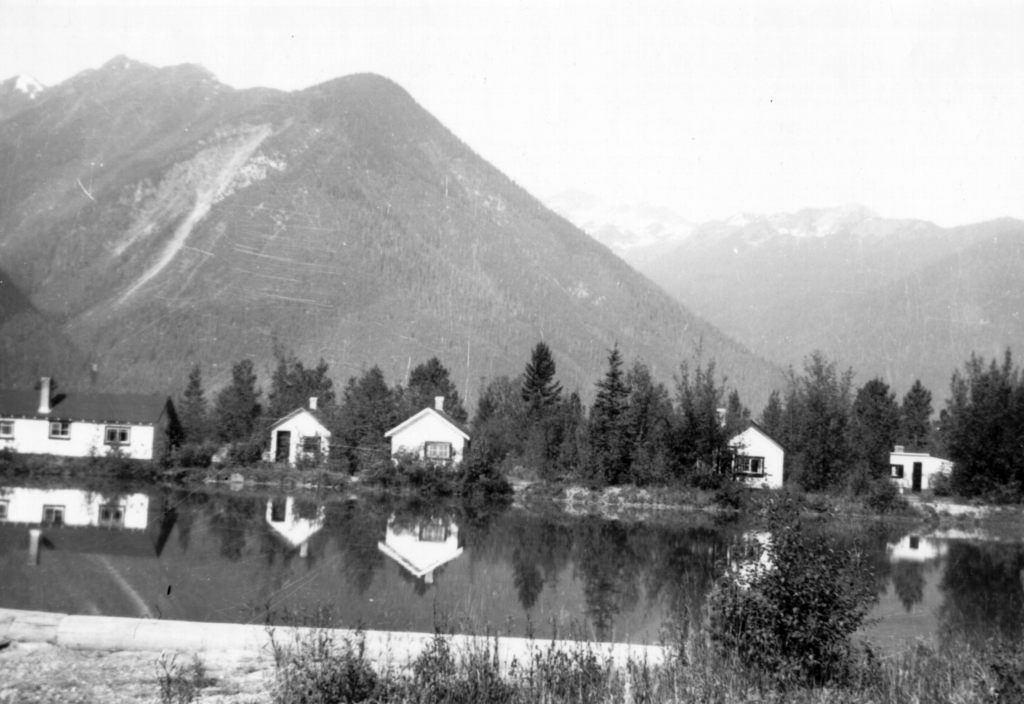Boat Encampment

The Story of Boat Encampment
By L.G. Temple – Reprint from the Mica Murmur – Golden Star, Mar 3, 1966
“Boat Encampment” is an odd name to be given a spot in the heart of the mightiest mountain range of a continent. Yet, when the reasons are given, it is obvious that no other could be more appropriate.
Aside from possibly, Tete Jaune Cache, it was the first place in this province named by white men. Situated at the apex of the Big Bend of the Columbia, where that stream is augmented by the flow of the Canoe and the Wood Rivers, the scene is of the same breath-taking beauty today as it was when David Thompson first saw it, in the late winter of 1811.
Thompson was on his way to the Pacific via the Columbia; and in order to travel down the river he had first to build boats. It was at this point that he built them, hence the name.
Here the long portage from over the Athabaska Pass through the Rockies ended at the mighty Columbia; and for some years this was an important junction on the main fur route of the province. With the removal of the HBC coast headquarters from Fort Vancouver on the Columbia to Fort Victoria on Vancouver Island, this route fell into disuse, and the voyageurs no longer made echoes resound from the mountains with their trail songs.
Thompson was probably the first to build boats here, and, according to his journal, he had considerable difficulty. In vain he and his men searched for suitable birch trees to rob of their bark for the construction of canoes. Plenty of birch were found and were big enough, but the bark was too thin to be satisfactory. Finally, they were forced to use an entirely different method of construction.
So, they split cut cedar boards and sewed them together with split spruce roots, as he says. “with the greatest difficulty.
Strangely enough, instead of going down the river, as anyone would have thought, he went upstream to the headwaters, and thence by many streams and portage, reached the Columbia again below what is now the U.S. boundary. However, on the way back he followed the main river, and it was this route from the Boat Encampment downstream on the Columbia. Which became, temporarily, the main artery of the Canadian fur trade from the coast.
Up to 1940, this old historic site was, to all intents and purposes, inaccessible to tourists; but with the construction of the Big Bend Highway it became possible to reach it by car. Today, while only a hamlet as far as size is concerned, it is an important point on the sparsely populated highway. It boasts a motel, the four-star class at that as well as a store and filling station.
(The original motel at Boat Encampment burned down and in its place now stands a lovely modern building which consists of a restaurant, dining room and motel units. Mr. and Mrs. Tingsted have created a warm and friendly atmosphere at the Inn and the food is delicious. To the south of the Inn is a thriving sawmill and to the north a trailer court and filling station. The small airport which serves the Mica Project is just a few miles northeast of the settlement.)

It also had as a novel sign to remind motorists to drive carefully as may be seen in the province. This consisted of a huge wooden head, topped by an old-fashioned “plug” hat. It was carved by an Italian workman during the road-building days of 1937-38. From the chin to the eyebrows it was the height of a man, and in front of it was a sign which read: “Don’t be a Wooden Head. Drive Carefully. You’ll Live to Enjoy the Scenery.”
(The Wooden Head which belongs to Boat Encampment was stolen some years ago and now stands near the highway at the Revelstoke turnoff. It would be interesting to find out how the wooden head got to Revelstoke. Perhaps someone could solve that mystery.)
Thompson, who gave his name to the Fraser’s principal tributary, was by no means the only famous man who stopped at Boat Encampment. Governor Simpson of the Hudson’s Bay Company journeyed that way on a trip to Fort George which replaced Fort Astoria on the lower Columbia. Then Douglas, who gave his name to the fir that plays a leading part today in our great lumber industry, also came over the old trail and camped at the famous stopping place.
A century and a quarter ago, the site of the Boat Encampment was a large grassy meadow along the river, surrounded by a heavy growth of huge evergreens. Since then the primeval timber has mostly disappeared, and the grassy meadow has been mostly washed away by the river. But the Selkirks and the Rockies are still as awe-inspiring as they were then. The famous Big Bend Highway follows along the shore of the Columbia all the way around the Big Bend so that the traveller can see the many rapids which often brought disaster to the old canoe brigades of the company.
Perhaps if you drive that way and stop at the famous old spot you may hear the ghosts of the voyageurs singing; that is, if your imagination is active enough. –
